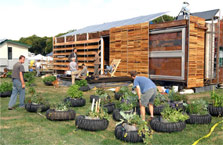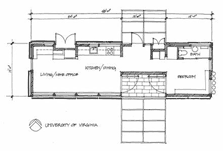

Virginia's 2002 home won rave reviews from the architecture judges for innovation and design.
Click drawing to view a larger image.

Solar Decathlon 2002
University of Virginia
Final Overall Points: 848.521
Final Overall Standing: 2
Winner, Design and Livability Contest
Winner, Energy Balance Contest
The house's design emphasizes technologies that we consider important for the future, and our goal is to integrate them into a lifestyle that is both ecologically aware and comfortable for the homeowner.
—Josh Dannenberg, University of Virginia student
About the Home
The exterior of the University of Virginia 2002 home was like no other. Early on, the students decided to use reclaimed and sustainable materials wherever possible. For the exterior finish, they selected copper cladding that was reclaimed from a roof. The design also featured a rain screen composed of wood reclaimed from shipping pallets. With the wood milled down and put into aluminum frames, the panels of porous wood stopped most of the rain and shaded the copper. They used engineered lumber (which uses a greater portion of the tree) for the studs.
Those same reclaimed pallets were also used as louvered window coverings. Tilted down, the louvers blocked the sun; tilted up, they reflected light up to the living room, acting as light scoops. The louvers could be opened to welcome the sun's rays in winter.
Although the University of Virginia house may look strange to the more traditionally minded, the team hoped that anyone would feel right at home once inside the house. Sustainable materials used on the inside include fast-growing, sustainable birch and bamboo.
The most intriguing feature inside the house was the "smart wall," the nerve center of the house, and it was the first thing you noticed when you stepped through the front door. This large, light-emitting diode wall reflected the home's temperature by changing color. When the house is warmer, it's one color; when the house is cooler, it's another color. A homeowner could also override the temperature feature and select the color or have constantly changing colors.
About the Team
All along, the 2002 Virginia team balanced aesthetics, environmental considerations, and engineering. Throughout the entire design and construction process, the team included 71 students from the School of Architecture, 24 from the School of Engineering and Applied Science, and 6 from the College of Arts and Sciences.
The Virginia decathletes were positive that the Solar Decathlon experience would help them in their careers. Said Josh Dannenberg, "I just graduated from architectural school. This is the perfect segue to working in an architectural practice. We're applying our design skills and actually building something. We're collaborating with people in the community and dealing and negotiating with contractors."
Key Home Features
| Item | Specifics |
|---|---|
| PV kilowatts (standard test condition rating) | 5.28 |
| PV modules | 16 ASE 330 |
| Charge controllers | 4 Trace C60 |
| Inverters | 2 Trace SW4024 |
| Battery bank | 2000 ampere-hour, 24 volt |
| Battery type | 16 Concorde PVX-2120 sealed absorbed glass mat |
| Water heating | 5 AET and 1 reclaimed flat plate collectors; 90-gal (341-L) storage; heat pump backup |
| Construction | Engineered studs, foam insulation; walls = R50 (RSI 9), roof = R70 (RSI 12); ground-coupled floor |
| Space heating | Passive solar with auto-control; ground source heat pump; radiant floor |
| Space cooling | Ground source heat pump; hydronic via natural convecting valance |
Manufacturers' Web Sites
- RWE Schott Solar Systems (formerly ASE Americas; ASE modules)
- Concorde
- Xantrex (formerly Trace; Trace charge controllers)
Source: These details have been adapted with permission from Home Power #94, April/May 2003
